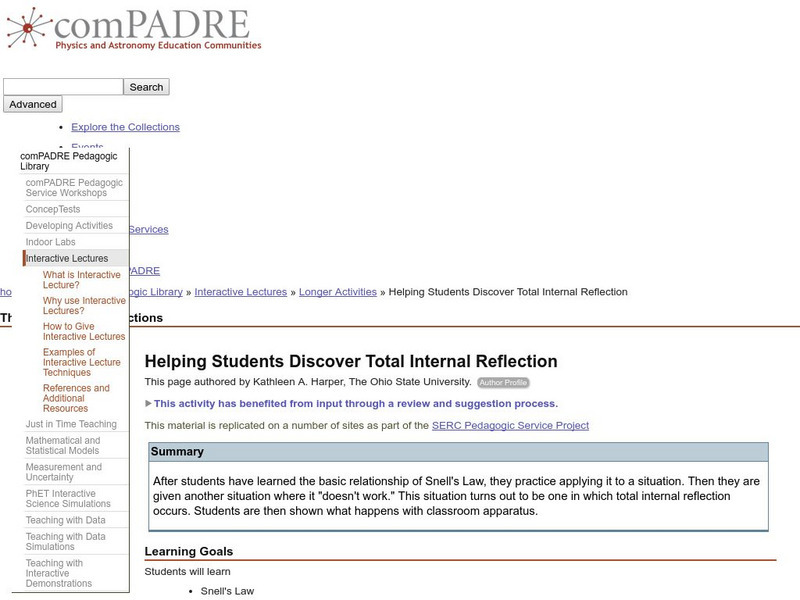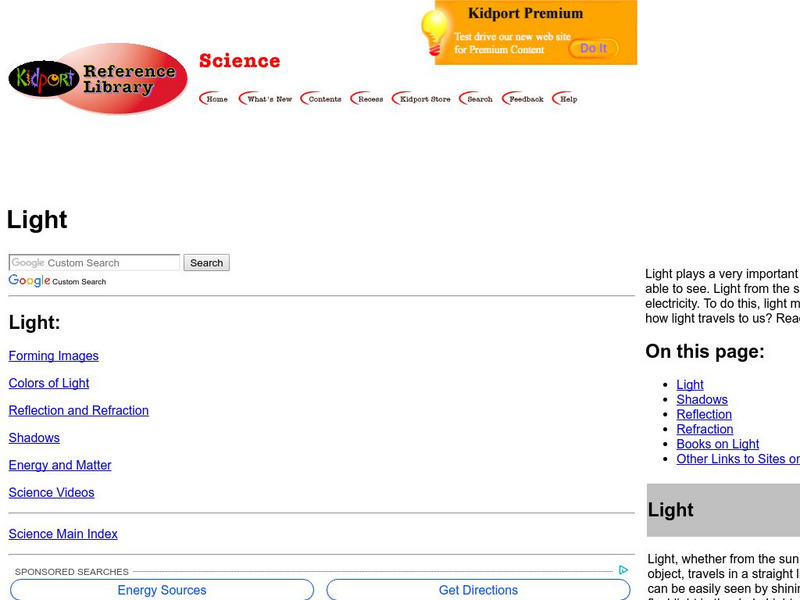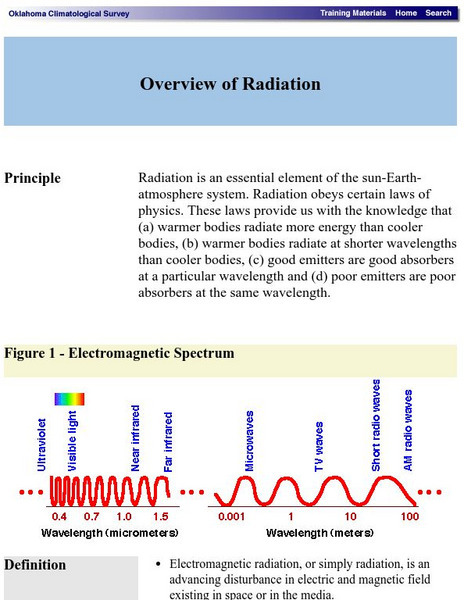University of Southern California
Usc Viterbi School of Engineering Illumin: Reflecting on the Mirrors
Article explaining what Digital Light Processing (DLP) technology is and how it works. Includes an animation to demonstrate the technology. (Published Fall 2007)
Georgia Department of Education
Ga Virtual Learning: Geometric Optics
This interactive unit will help students to understand the basics of geometric optics. Learn what happens when light strikes the boundary between two media as well as the difference between a real and virtual image? Also explore the law...
PBS
Pbs Learning Media: Laser Waterfall
In this video from the Encyclopedia of Physics Demonstrations, students will observe how a laser beam is trapped in a water jet because the light reflects against the surface of the water. [1:03]
TeachEngineering
Teach Engineering: Security System Design
Students apply everything they have learned about light properties and laser technologies to designing, constructing and presenting laser-based security systems that protect the school's mummified troll. In the associated activity,...
Other
Usps: Polar Lights
You and your students are going on an expedition to learn about the polar regions. Explore the glaciers, subglacial rivers, and volcanoes. Get up close and personal with furry, flippered, and feathered friends. Learn how other people...
National Gallery of Art
National Gallery of Art: The Elements of Art: Color
Students will be introduced to color, one of the basic elements of art, through analysis of works of art by Monet, Matisse, and Kandinsky. Class discussion focused on these paintings will help students understand how artists use color to...
CK-12 Foundation
Ck 12: Physical Science: Law of Reflection
[Free Registration/Login may be required to access all resource tools.] Reflection and how it produces an image, regular and diffuse reflection and the law of reflection.
Physics Classroom
The Physics Classroom: Reflection and Mirrors: Name That Image Interactive
Students participate in this skill-building activity where they explore how the location of an object in front of a curved mirror affects the characteristics of the projected image.
Optical Society
Optical Society of America: Optics for Kids: Make a Light Fountain
A simple experiment that demonstrates the concept of total internal reflection, and shows how light can travel around curves and corners, as it does in fiber-optic cables. Accompanied by an explanation of what's happening.
Science Education Resource Center at Carleton College
Serc: Helping Students Discover Total Internal Reflection
After students have learned the basic relationship of Snell's Law, they practice applying it to a situation. Then they are given another situation where it doesn't work, which turns out to be one in which total internal reflection occurs.
Optical Society
Optical Society of America: Optics for Kids: Make a Green Gumball Black
An experiment to investigate what colors are seen when light is absorbed or reflected by colored gumballs. With links to scientific, academic articles that explain what is happening.
Discovery Education
Discovery Education: 3 M Young Scientist Lab: Gelatin Optic Fibers
Strips of gelatin dessert and a laser pointer demonstrate total internal reflection.
TeachEngineering
Teach Engineering: When Silicon Talks
In this activity, students tackle this aspect of engineering as they solve problems for precise angles and speeds, and predict data output when samples are altered.
Kidport
Kidport: Light
Did you know that light is a form of energy and always travels in a straight line? Discover some more interesting facts about light.
Science Education Resource Center at Carleton College
Serc: Investigating Light: A Form of Energy You Can See
Young scholars will investigate how light is a form of energy that travels as waves away from the source. The basis for this lesson plan is taken from the Houghton Mifflin science curriculum. In the lesson plan experiments, students will...
Georgia State University
Georgia State University: Hyper Physics: Total Internal Reflection
This physics department site provides a definition and explanation of the phenomenon of total internal reflection. Includes a diagram and an equation for calculating the critical angle for light approaching a surface.
Other
Open School Bc: Sound and Light
The Sound and Light interactive investigates these two forms of energy. Students will enjoy exploring how sound and light are created, travel, and can be controlled.
Discovery Education
Discovery Education: Science of Everyday Life: Light and Shadow [Pdf]
In this lesson plan, students experience how light interacts with the environment by investigating relationships between shadows and light. Students will experiment with light by observing how light travels through materials and distances.
Physics Classroom
The Physics Classroom: Blue Skies and Red Sunsets
This high school resource shows how the blue of the skies and the red of the sunsets can be explained by the interaction of sunlight with atmospheric particles which causes scattering of light.
Other
Guidance/the Alphabet of Art/value
An informative site that explains Value as an element of art using examples of Rembrandt's work. This is a good juxtaposition between the works "Night Watch," and "The Anatomy Lesson," by Rembrandt.
Oklahoma Mesonet
Oklahoma Climatological Survey: Overview of Radiation
This site details what radiation is, the physics of radiation, and radiative transfer as it occurs in nature. Content explores the electromagnetic spectrum, electromagnetic waves, properties of radiation, and solar radiation.
ClassFlow
Class Flow: Introduction to Light
[Free Registration/Login Required] This flipchart introduces fifth graders to the science of light. Principles such as transparent, translucent, opaque, reflection, and refraction are covered. Concave and convex mirrors and lenses are...
Optical Society
Optical Society of America: Optics for Kids: Guiding Light Optical Fiber
This experiment demonstrates the concept of total internal reflection, using basic materials. Accompanied by a detailed explanation of what's happening, and links to articles on reflection and refraction.
Pennsylvania State University
Penn State Graduate Program in Acoustics: Reflection From Mirrors
Included here are illustrations of reflections from a plane mirror, a concave mirror and a convex mirror.













